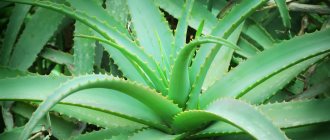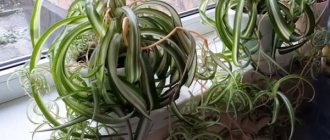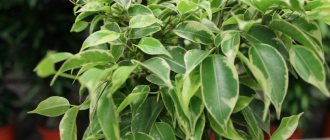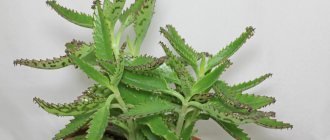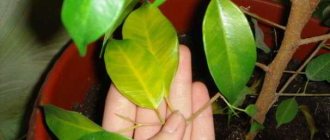- October 31, 2018
- Miscellaneous
- Marina Nikolaeva
Once upon a time, no more than twenty years ago, chlorophytum was one of the most popular indoor plants. It could be seen in almost every room of a house or apartment - in bright rooms, dark corridors, and the kitchen. This flower also decorated government institutions: in sanatoriums and hospitals, this tropical guest was comfortably located in the hallways; in schools, pots with it hung or stood in classrooms and corridors.
Unfortunately, today chlorophytum is undeservedly forgotten. In our opinion, it is completely in vain. The plant has remarkable decorative characteristics, does not require complex care, and is perfect for beginners who love indoor plants to gain experience. In this material we will tell you about this ornamental plant - how to care for it, water it, and how to replant chlorophytum.
Historical reference
An ornamental deciduous herbaceous plant - chlorophytum is a perennial epiphyte. In other words, in nature it grows on other plants without receiving nutrients from them. Initially, it was classified as a member of the Lily perennial family. Modern researchers do not have a consensus on this matter. One group of scientists classifies chlorophytum as a member of the Agave family, and another group as one of the Asparagus family.
Europeans learned how to grow chlorophytum more than 200 years ago, when plants were brought to the continent from the humid subtropics and tropics of Asia, Africa and South America. It is known that the brilliant German writer and philosopher Johann Goethe himself grew it in his home in hanging containers and always admired the spectacular appearance of the plants and the charming little children that hung around the mother bushes.
The name of the plant can be literally translated as “green plant.” In nature, in regions with high levels of humidity and heat, it is not easy for chlorophytum to survive. That is why this exotic guest feels so comfortable at home, giving the owner not only his beauty, but also useful and healing properties.
Chlorophytum in the interior
The versatile and unpretentious flower Chlorophytum fits perfectly into any interior of the bedroom, kitchen and living room. Chlorophytum at home can be placed:
- In standard flowerpots on desks and coffee tables, cabinet shelves and even kitchen refrigerators.
- Plants are perfect for growing in hanging pots. At the same time, the location of the flower can be limited almost only by the designer’s imagination. The green pet can live not only in arches and doorways, but also above the kitchen sink and work area.
Useful properties of the plant
After numerous studies, scientists were able to prove that chlorophytum has a truly unique ability to remove formaldehyde, all kinds of toxins and impurities from the air around it. The phytoncides secreted by its leaves purify the air in the room from pathogenic microbes and saturate it with oxygen. It has been proven that in just a day, the flower kills about 80% of the bacteria in the air surrounding the bush. Three or four mature plants can easily clean a 10-square-meter room. m.
A flower placed on a kitchen windowsill absorbs harmful emissions from electrical and gas appliances. In the vicinity of pelargonium (indoor geranium), chlorophytum absorbs dust and microbes in rooms. For this feature it is often called a vacuum cleaner flower. The plant regulates the air humidity in the room and also improves its microclimate, since the leaf plates accumulate moisture and then release it into the surrounding atmosphere, being a kind of natural air humidifier.
By growing chlorophytum in your apartment, you can automatically improve your quality of life. This is especially important for people who suffer from bronchial asthma, allergies or low immunity.
What does chlorophytum look like?
The plant Chlorophytum belongs to the Asparagus family. Depending on the variety, it can reach a height of 25 to 55 cm. The arched long leaves of the plant come in a solid green color, as well as with lighter stripes along the entire surface of the leaf blade. However, modern selection is developing new varieties with different shapes and colors of leaves.
What does a chlorophytum flower look like when grown as an hanging plant?
Briefly about the history of appearance
The homeland of chlorophytum is the lowlands of rivers in the tropics of the American continent. The plant is most often found in its natural environment in South Africa.
Common varieties
The most famous variety of ornamental plant is Chlorophytum crested. Its stem is shortened and the leaves are light green in color. Another common variety in floriculture is Chlorophytum cape. The leaves are lanceolate in shape and taper towards the end. Chlorophytum winged has wide, dark green, lanceolate, oval-shaped leaf blades. The petioles of the plant are orange in color.
Note! It is up to everyone to decide which variety to choose for home cultivation. The care rules are the same for all varieties.
Is it possible to plant chlorophytum outside?
The flower can be planted in open ground in spring and autumn. Outside in the summer, chlorophytum grows better, due to the space for the growth of the root system, natural light, constant ventilation and nutrients in the ground. However, before frost sets in, gardeners replant the flower in a pot and bring it home.
External features of the plant
Chlorophytum has a short stem. The length of its leaves can vary depending on the variety. They are the longest (up to 60 cm or more) in hanging varieties. The narrow leaves with pointed ends have a linear-lanceolate shape, much less often – oval. They are collected in lush rosettes or bunches.
The bush grows in height and width approximately equally – by 50 cm. Cases have been recorded when an adult healthy plant grows up to a meter in height and in diameter, its leaves create magnificent cascades up to one and a half meters in length. On average, a perennial lives about 10 years.
Long shoots with aerial roots and small leaves grow from the center of the bush. In summer and spring, chlorophytum produces long, curved peduncles. At their ends appear small silvery-white star-shaped flowers, a bit like tiny lilies. They look very original against the background of long green or variegated leaves.
When the flowers fade, fruit boxes appear, as well as small rosettes with leaves and aerial roots. These are the children of chlorophytum. The flower has tuberous, thickened roots, colored brown or yellow. They can accumulate such an amount of moisture that the plant can live without watering or spraying for up to a month. In this case, your pet will lose its decorative appearance: the beautiful long leaves will fade and droop along the edges of the pot. However, the plant will not die, but will wait patiently until the owner remembers it. As soon as watering of chlorophytum is resumed, it will come to life again and very soon restore its attractiveness.
Chlorophytum transplant
The rules on how to replant a chlorophytum flower include the following recommendations:
- The procedure should be carried out once every 1-2 years. Signs that replanting is necessary include stunted growth, roots falling out of water drainage holes, and lack of growth and flowering.
- It is best to replant in early spring, but if all the rules are followed, the flower will take root well in the new pot throughout the year.
- The new pot should be at least a quarter larger in diameter than the previous one.
- The plant is removed and the root system is cleaned of the old substrate. Inspect for diseases and pests.
- Place in a new pot with soil and a drainage layer and act in the same way as during initial planting.
Types and varieties
Today there are more than two hundred species and varieties of this wonderful plant. However, only a few of them are common in indoor floriculture.
- Crested
It is a native of South Africa. Chlorophytum crested has long (up to 50 cm) saber-shaped leaves. White longitudinal stripes run along their edge. The leaves are collected in bunches, from the center of which arrows grow. They can be spread out or hanging, much less often - curly.
Daughter rosettes are formed at their ends. Initially, the leaves of this plant species were uniformly colored green. Later, varieties were developed with leaves decorated with longitudinal yellow-cream or white stripes in the center.
- Curly
This chlorophytum resembles a bush of dense grass with long and wider leaves that are covered with alternating light and dark green stripes. Hanging leaves curl at the ends. The flower looks very neat and compact. It forms simple inflorescences in the form of panicles.
- Winged (orange)
This species has unusually colored petioles on which the leaves are held. They are painted brick orange or orange-pink. The leaves are typical of chlorophytum - dark green and long. They taper towards the ends. As a rule, at home, propagation of this species of chlorophytum is carried out by seeds, much less often by root rosettes. The plant blooms with small orange flowers. Experienced flower growers recommend removing flower stalks in a timely manner so that the petioles do not lose their bright color.
Types of chlorophytum
The most common species among gardeners are very decorative. Each has its own unique charm.
Chlorophytum crested
Chlorophytum crested
This is one of the most common chlorophytums in homes. Tufts of long leaves are raised 20-25 cm above the pot; the plant itself can reach a height of 50 cm. The roots of this species are quite long, small containers fill very quickly.
The plant blooms with white or greenish flowers, the long stems are decorated with them evenly, as if they were deliberately placed at regular intervals.
After the bush fades, sprouts (stolons) form at the tips of the inflorescences. They sink to the ground, cling tightly with thin roots and form a baby. From each such child a new young chlorophytum can arise.
Chlorophytum curly (bonnie)
Chlorophytum curly (bonnie)
A very beautiful flower. If you imagine that long green leaves with a central white stripe curved in a spiral, dropped down and completely covered the pot with gentle waves, this would be a bonnie. Capable of educating children, unpretentious and smart.
Chlorophytum cape
Chlorophytum cape
It is slightly different from the others in that it does not form rosettes. It has narrow (no more than 3 cm) leaves with white stripes along the edges and a very powerful rhizome. The flowers are small, beautifully arranged on short peduncles. It can only be propagated by dividing the bush.
Chlorophytum orange (winged)
Chlorophytum orange (winged)
A chic type of chlorophytum, the beauty of which is emphasized by the colored petioles of wide glossy leaves. The winged bush has another name - orchid star. This is understandable, since the petioles, which can be pink, red, or brown, form a spectacular star.
Chlorophytum laxum
Chlorophytum laxum
A rare plant with shiny leaves decorated with white stripes on the sides, located on long petioles. It blooms with a “spikelet” inflorescence and reproduces only by dividing the bush.
Chlorophytum: home care
Perhaps this is the most resilient and unpretentious indoor flower known today. This is why it is suitable for beginner gardeners - you will get excellent practice and will not be disappointed with the result.
Caring for chlorophytum at home is extremely simple: the plant can withstand any conditions - a dark corner or a bright window, regular watering or moistening once a month. By its appearance, chlorophytum informs its owner about a mistake. Moreover, he will give you time to fix it, and if you take this chance, he will again thank you with a magnificent decorative look. Nevertheless, we will introduce you to the conditions that are most comfortable for this flower.
Description of the plant
Chlorophytum flower is a herbaceous plant that currently grows in South America and Australia. The plant’s homeland is Australia, but in Russia the flower does not like hot climates and cannot withstand increased dryness indoors.
But it can withstand well in dry soil for more than a week, so it is actively grown by people whose work involves business trips.
At the moment, there are about 250 species of this plant. In its regard, the following advantages and features of the flower can be distinguished:
- Chlorophytum blooms, although this is rarely observed. This happens in March, the flowering period lasts the entire growing season.
- In the period from October to January, the flower begins a dormant period - it needs to be watered less often and not use bait.
- The plant will easily lose its decorative effect if the tips of its leaves dry out, which happens all the time due to improper care.
- It is generally accepted that chlorophytum looks more interesting on a stand or in a wall pot. But it can often be found in a flowerbed in a garden plot.
The presented flower can be grown separately or used to create a composition.
Chlorophytum crested / Caring for chlorophytum at home
Lighting
For this light-loving plant, diffused lighting is quite comfortable. Chlorophytum grows and develops well in such conditions. He likes the location near western or eastern windows. It will also take root on a bright windowsill of a south-facing window, but in this case it should be slightly shaded at midday to protect the leaves from being burned.
Chlorophytum varieties with green leaves can grow even in dark corners. True, its flowers will not be as rich and smaller; in this case, the daughter rosettes develop less actively.
If you are interested in how to plant variegated chlorophytum, then it should be noted that it does not like too shaded places - quite quickly the bright stripes will disappear from the leaves and they will become monochromatic green.
When and how does it bloom
Chlorophytum crested - description and care at home
The flowering of chlorophytum is very modest and is not a valuable quality. Cute star flowers look good only with exceptional care. If flower stalks do not appear, this indicates that the plant is too young or is too cramped in the pot.
Chlorophytum flower does not evoke sympathy among gardeners
The flowers are simple white, up to 2 cm in diameter, with five petals and six long stamens with yellow anthers at the tips. The second variety is a cob up to 5-7 cm long, found in orange-leaved varieties, dotted with the same small white or yellowish flowers.
Flowering period
If the pot is spacious enough and the plant receives enough light, then new shoots with buds will appear regularly, regardless of how many there are already on the bush. One arrow blooms for about a month. After the last bud withers, young rosettes of leaves will begin to grow at the ends. At this time, if there is no desire to propagate the bush, then the peduncle is carefully cut off at the base. But many people prefer to leave them, finding this a special charm of the plant.
Watering the plant
Our exotic guest loves moist soil. Abundant and frequent watering of chlorophytum is recommended from spring to autumn. In winter, moderate soil moisture is sufficient. During the heating season, the earthen ball dries out quite quickly even in winter, so try to keep it moist, avoiding waterlogging.
Unlike the overwhelming majority of indoor plants, chlorophytum, without being capricious, drinks tap water, which is left to settle for 24 hours. If the plant lacks moisture, the leaves begin to dry out and the roots become covered with additional tuberous thickenings. When overwatered, if there is always water in the tray, the tips of the leaves of the chlorophytum turn black and its appearance deteriorates.
Planting chlorophytum
The technology for planting chlorophytum is not much different from the procedure for other indoor plants:
- Before planting, everything necessary is prepared: pot, soil, water for irrigation.
- A drainage layer of vermiculite, expanded clay or clay shards must be laid on the bottom of the pots.
- A small layer of earth is poured. If the soil is homemade, then it is better to first calcine it in the oven or microwave for 5 to 20 minutes.
- The plant is carefully placed in the pot, the roots are straightened.
- The empty space is filled with soil mixture, which is slightly compacted.
- The planting procedure is completed by moderate watering with warm, settled water.
Choosing a flower container
Which pot is needed for chlorophytum is determined only by the owner of the plant. Only he decides in what container it is more convenient to grow a flower - in a flowerpot, in a pot, hanging varieties - in wicker hanging baskets and flowerpots. Chlorophytum grows well even in hydroponics. The root system of this plant will easily master a pot of any size and type. The only factor to consider is that ceramic pots or thick-walled flowerpots are more suitable for mature plants. Plastic pots with thin walls cannot withstand the powerful pressure of the root system and burst.
Pot for chlorophytum
Experienced plant growers claim that the chlorophytum flower is very unpretentious and resilient. Even a novice florist can handle it, and it is highly recommended that they get this green pet at the beginning of their hobby. It is only important to plant the crop correctly, choosing the right pot:
- The chlorophytum plant is not too demanding on its growing container. For young flowers, plastic containers that match the diameter of the root system are suitable. It is recommended to plant older plants in large ceramic pots, because weaker plastic may not withstand the pressure of a powerful root system.
- In the house, the flower looks good both in the usual window planters and in hanging baskets and wicker planters for ampelous forms.
Soil selection
You don’t have to worry about what kind of soil is suitable for chlorophytum. The plant feels great in any universal soil composition for indoor plants. It is necessary that the substrate must be moisture-absorbing, well aerated and loose. In heavy soil, the plant most often slows down its growth, its root system is inhibited, and the above-ground part becomes less lush and elegant.
If you do not have the opportunity to buy ready-made soil, make it yourself from equal parts of leaf soil, turf soil, humus sand and peat.
Transplantation is a requirement
The roots of chlorophytum are very dense, wide, elastic with oblong tubers. Even in one year they grow greatly, so regular transplanting into a larger pot is simply necessary. If this is neglected, the plant may stop growing and stop forming flower stalks.
In a cramped pot, the roots of chlorophytum are tightly intertwined; it has long needed a transplant
It is simply impossible to grow a large and beautiful chlorophytum bush without ever replanting it. The main reasons for the necessary replanting: either the pot has become cramped, or the need to renew the depleted soil with a more nutritious one.
Video: replanting after purchase, replacing the soil mixture, moving to a pot of the right size
Step-by-step instructions for replanting homemade chlorophytum
- Water the plant generously and let it stand for a while so that the soil softens and the roots are not damaged when digging out the earthen ball.
- As soon as the flower along with the soil is removed from the pot, the chlorophytum should straighten the roots, being careful not to damage them.
The chlorophytum roots curled up in a cramped pot need to be helped to straighten out.
- Having removed excess soil from the roots with your hands, we place the bush in a prepared container with a new or updated nutrient mixture.
- After replanting, water the plant again.
- If a pot of suitable size is not found, you can plant the chlorophytum in two or three smaller pots, carefully dividing the bush with a knife along with the roots.
Video: how to transplant chlorophytum into the correct soil
Chlorophytum is ready to grow in any soil, but if you intend to grow a healthy and lush bush that can reward you with beautiful foliage and active flowering, it is important to plant it in a nutritious substrate. The most suitable soil mixture consists of equal parts of leaf and turf soil, humus and river sand.
If the soil mixture is purchased in a store, it is recommended to take a light substrate with a pH level of 6 to 7.5, since the crop prefers slightly acidic soil. If you are not in the mood to bother with preparing the soil for the flower, then take any, because under other favorable conditions, chlorophytum will forgive you this negligence.
Video: to grow a beautiful bush, take care of the right soil composition
Planting in hydrogel
In addition to soil, hydrogel is excellent for growing. But when using it you need to adhere to some rules. To plant in hydrogel, it is better to take a young plant - the adaptation process will go much faster than in an adult. If the plant was previously in the ground, the roots should be washed thoroughly before immersion in the hydrogel. Add water to the swollen hydrogel rarely and carefully. Do not place a plant planted in hydrogel in a place that is too bright. Do not forget to fertilize occasionally; the solution with fertilizing should be slightly concentrated. The hydrogel should be washed periodically in running water to avoid possible unpleasant odors.
It is better to plant young plants in hydrogel
Can be planted in a florarium, or temporarily in an aquarium
In small apartments, a florarium is a worthy replacement for bulky greenhouses. Thanks to the closed space, it maintains a special microclimate favorable for the growth and development of many plants.
Chlorophytum can also be grown in florariums, but not in fashionable mini ones, where due to its rapid growth it will have to be constantly replaced with new specimens. and in larger ones, for example, in large aquariums or display cases, both open and closed.
In large florariums there is always a place for chlorophytum
Some people use chlorophytum for landscaping aquariums. But we must remember that the plant will not be able to be submerged under water for a long time - after a few months it will have to be taken out and planted in the ground. But you can root cuttings in an aquarium.
Video: an attempt to place chlorophytum in an aquarium
Top dressing
Chlorophytum planted in soil for ornamental plants, as a rule, does not need feeding. However, experts recommend feeding chlorophytum twice a month in spring and summer with liquid fertilizer, which stimulates the plant to form daughter rosettes.
You will immediately notice from the faded and drying leaves that the composition of the soil mixture is too poor. Only weekly liquid feeding while watering the plant will help save the situation. Any complex fertilizer in the dose recommended by the instructions is suitable for this purpose.
Caring for the finished flower
Chlorophytum is an unpretentious plant that does not require much attention when caring. But for a native of the tropics to fully develop, he still needs to create optimal conditions:
- glaze;
- temperature;
- lighting;
- nutrition.
Soil moisture, watering
Chlorophytum thrives in moist soil, although it can survive short-term drought. Optimal watering conditions are:
- In spring and summer, the soil is moistened regularly and abundantly;
- The water that has flowed into the pan is removed;
- young plants need frequent moisture;
- In winter, during the resting phase, watering is reduced, preventing the earthen clod from completely drying out;
- water should be filtered or settled tap water at room temperature.
Reference! Chlorophytum responds well to regular spraying of leaves in the warm season.
What lighting is suitable?
Chlorophytum is not picky about the amount of light, but you should pay attention to the following conditions:
- The plant will also grow on the windowsill of a north window.
- Optimal light conditions for it are on the eastern and western sides of the room.
- To preserve color, variegated types of chlorophytum should be exposed to diffused sunlight for 3-4 hours daily. Then the plants will delight the owners with the bright colors and lushness of the bush.
- Prolonged exposure to the sun's rays leads to leaf burns.
- With a lack of lighting, the plant fades and loses its attractive appearance.
Fertilizing the soil during transplantation
Purchased or prepared according to the rules, the soil mixture contains all the necessary nutrients. After transplantation for 4-5 months, chlorophytum does not need additional feeding.
During the growing season from April to September, complex fertilizers for deciduous plants are applied to the soil twice a month. Also, to increase the number of leaves, growth stimulants are added to the fertilizer. Fertilizers are applied after watering to avoid burning the roots. In winter, during the resting phase, feeding is stopped.
Reference! To replenish the soil with organic matter, you can use water from the aquarium.
3/5 — (3 votes)
How to transplant chlorophytum?
This perennial, which has a powerful root system, grows very actively. The roots of the plant quickly fill the container, displacing the soil. Therefore, it is important to know how to transplant chlorophytum. As a rule, this procedure is carried out in early spring. Prepare a pot in advance, 2-3 cm larger in diameter than the previous one.
Remove the plant from the pot, shake off the soil from the roots and, as far as possible, disassemble them with your hands and straighten them. Place a layer of drainage (2-4 cm) at the bottom of the new pot. Place the chlorophytum in a new container with fresh soil. While filling the pot with substrate, gently shake it to fill all the voids.
After replanting, chlorophytum should be watered abundantly so that all the soil is saturated. Drain excess moisture from the pan after some time. Place the plant in a place protected from sunlight. After three days you can move it to a permanent place.
It is possible to replant chlorophytum in the fall if you notice that the flower has become cramped in the pot. In a container that is too cramped, as well as in a container that is too spacious, the plant may refuse to bloom.
Pests and diseases
I repeat like a mantra: if, when caring for a plant, you fulfill all the requirements of agricultural technology and if you treat all your plants responsibly, then diseases and pests will bypass your home flower garden. But, as they say, no one is immune from mistakes, so it’s better to assume the worst and be prepared for it.
So, among the pests that are dangerous for chlorophytum are thrips, nematodes, aphids, spider mites, and mealybugs. And if one of these insects appears on your plant, the first thing you should think about is: what did I do (or have done) wrong? Think about this while you are exterminating pests, and take all measures to avoid their second coming.
As for chlorophytum diseases (various spots, root rot and bacterial diseases), they arise solely due to violation of the rules of plant care. Let's look at what problems arise from what violations.
- Epiphyllum at home
Chlorophytum dries
If the chlorophytum leaf dries only from the tip, then it is likely that the problem is excess sodium in the soil. Stop feeding the plant with fertilizers that contain sodium, and the plant will gradually recover. Sometimes chlorophytum turns black and dries from the end of the leaf, if the soil in the pot is dry for a long time in hot weather or the air humidity is not high enough - check your suspicions and eliminate the lack of care.
Chlorophytum turns yellow
There may be several reasons. Firstly, the lower leaves may turn yellow due to chronic waterlogging of the soil, as a result of which the roots rot. It is necessary to transplant the plant into fresh soil, first removing all rotten and blackened roots. And now you will have to pour water into the soil taking into account the experience gained.
Sometimes the leaves turn pale and yellow due to lack of lighting - move the chlorophytum closer to the window or organize artificial lighting. When the roots are crowded in the pot and the plant lacks nutrients, the leaves begin to signal this by gradually changing their color from green to yellow. Try to be attentive and quick-witted in order to be able to help the plant in time to get rid of the problems that it has developed due to your fault.
Well, a few more tips on how to rid your plant of diseases and their symptoms:
- brown spots on the leaves of chlorophytum - due to excessive watering at low indoor temperatures;
- wrinkled edges of brown leaves are caused by chronic drought of the top layer of soil;
- If in winter the leaves turn pale and fall off, it means that the chlorophytum is too hot and not light enough.
Air babies
The simplest, and therefore the most popular, method of propagating chlorophytum. Although children greatly decorate the plant, an excessive number of them should be disposed of - too many offspring weaken the flower. You can root children year-round in one of three possible ways.
- Select the strongest rosette, carefully separate it from the mother plant with a disinfected sharp knife and place it in a glass of settled water for rooting. Soon the roots will appear and grow. When their length reaches 2 cm, transplant the young bush into the prepared pot. Overgrown roots are very brittle and fragile, they can easily be damaged during planting.
- Do not separate the selected strong and healthy shoot located at the end of the shoot from the bush. Bury it in a separate container placed nearby. When the baby takes root, the shoot needs to be cut off.
- If for some reason you don’t like this method, then you can cut off the baby from the frog and immediately bury it in a pot of soil. Water the seedling and cover with a bag or jar. The rosette will quickly take root, since at the base it has small aerial roots, from which a powerful root system will be formed.
Reproduction of chlorophytum
Growing from seeds
You can simply buy chlorophytum at a flower shop and not complicate your life by growing it from seeds, but if there is a breeder in you, then you will definitely want to try this particular method of propagation. It should be remembered that the germination rate of chlorophytum seeds is low - 25-40% depending on the variety, so for greater reliability, soak the seeds wrapped in gauze for a day before planting in water, which you change every four hours.
- Caring for milkweed indoors
So, the seeds are sown in early spring directly on the surface of a light, moistened substrate of sand and peat, lightly pressed against it, covered with film or glass, creating a greenhouse effect in the container with the seeds, and placed in a warm place (22-25 ºC), in partial shade , regularly ventilating the container and moistening the soil by spraying. The seeds will germinate in a month and a half. When 2-3 leaves appear, the seedlings are planted in personal pots with soil for adult chlorophytum.
Do not forget to accustom the seedlings to the environment before this - open the greenhouse for a short time during the week so that the sprouts get used to the temperature and humidity of the air in the room in which they will grow.
Dividing the bush
When replanting a specimen older than 3-4 years, you can divide its bush and plant the sections in different pots - this will be a vegetative method of propagating chlorophytum by dividing the bush. Water the substrate in the pot before replanting; after a few hours, remove the plant along with the earthen lump and use a sharp knife to separate the roots, being careful not to destroy the lump. Carefully examine the roots of the divisions, remove rotten and dried ones, and then plant parts of the plant in new pots.
Reproduction by lateral shoots
There is another vegetative method of propagating chlorophytum: the lateral shoots with daughter rosettes are separated from the mother plant and immediately planted in a permanent place in the soil for an adult plant. If it seems to you that the rosette may not take root in the soil, then place it in a vessel with water for several days so that the weak roots grow, and then plant it in the ground. Chlorophytum children can be separated and planted at any time of the year.
Reproduction methods
The characteristics of the species allow the flower to be propagated in different ways. Flower growers choose the appropriate option from the listed methods.
Seeds
Seed propagation is an uncommon method used to obtain seedlings. Seeds are sown on prepared soil, the first leaves appear from the ground after 3 or 5 months.
Dividing the bush
The rosette is planted when there is excessive branching. This helps not only to get a new plant, but is also a method that rejuvenates the mother flower. The plant can be replanted in spring or autumn. The overgrown chlorophytum is divided into 2, 3 or 4 parts.
Daughter sockets
The species reproduces by transplanting a daughter rosette. This method is called propagation by cuttings. The rosette is carefully separated from the adult bush and placed in a container with a solution that stimulates growth. After the roots appear, the rosettes are planted like adult plants.
Rooting air babies
Air babies appear on the tendrils of chlorophytum after flowering. They are rooted in an adult pot by dripping. The appearance of leaves means that the baby was able to take root successfully.
Attention! Air babies are not cut from the mother plant until they take root on their own
Different types
A huge number of varieties and types of chlorophytum have been bred today; they amaze with the variety of leaves. Caring for plants at home is also varied. Below is information about the varieties and their photos.
Variegatum has bicolor stripes on the leaves, both green and white.
Cape does not form rosettes on the arrows.
Bonnie is also called curly because the leaves curl like hair.
Crested has narrow, emerald-colored leaves and white flowers.
The winged species has very unusual leaves, different in shape from other species, lanceolate, located on long red petioles.
Green Orange has dark leaf blades with orange petioles and the same veins.
Among the variety of these decorative foliage plants, you can find others with unusual foliage and color.
Please note! Chlorophytum is one of the favorite plants for representatives of the cat family. They enjoy eating it
They eat it with pleasure.
What kind of care does he need?
- Light. This is a rare domestic species that loves direct sunlight (albeit for a maximum of a couple of hours a day). An eastern window sill is best suited for him. After lunch, the plant prefers to be in light shade.
- Temperature. In summer, any (so the plant is comfortable even in a balcony box), and in winter - no lower than 10 degrees.
- Watering. In summer, chlorophytum needs moisture, so use a watering can every 2-3 days. In winter, you can water it less often, and if you allow the soil to dry out completely, the flower will survive this. The plant also responds well to wick watering, which you can do with your own hands when replanting a flower.
- Feeding. In spring and early summer, chlorophytum can be given a mixture for decorative leaf plants. It is applied once every 14 days.
- Transfer. A good time is the end of winter and the beginning of spring. “Old bushes” are replanted every few years, young bushes – more often, once a year. By the way, in addition to pots and cache-pots, this plant can also be planted in a flower bed (and transplanted back into the house in the fall). It is "friendly" so can be planted in a pot with other flowers.
- The soil. The plant likes loose, nutritious, neutral soil. A good option: sand (1 part), leaf soil (2 parts), turf soil (2 parts), humus (1 part).
- Diseases. Rarely, but still, chlorophytum suffers from root rot. He may also get a bacterial infection. All these problems arise from overwatering, so water your pet infrequently and sparingly. If the tips of its leaves begin to dry, then on the contrary, you are giving the plant too little water. Or maybe chlorophytum is asking to be sprayed (this procedure is very desirable for chlorophytum in the summer months).
- Dangerous insects. The beauty of the plant can be spoiled by spider mites, as well as aphids, nematodes, and mealybugs.
- Special conditions of care. The plant produces tendrils profusely and expands in the pot. Therefore, many gardeners often prune the bush, forming a beautiful “picture” and removing all that is unnecessary. From mid-autumn to early winter, the plant goes into hibernation; do not feed it and water it rarely. Then it will “wake up” and may even bloom.
Reproduction of chlorophytum
The bush can reproduce by seeds (although it is not easy to collect them - they are very small), by dividing the bush (relevant for old bushes growing in your house for more than 3 years; this procedure can be combined with replanting), but the most popular and simplest way is by lateral shoots, that is, sockets.
Everything is done like this:
- Cut off the strong rosette from the tendril.
- It is advisable to choose one that has already acquired roots. But if you are in a hurry and there is little choice, place the socket in a glass of water. There is no need to keep it there for a long time - from 2 to 5 days will be enough.
- Now you can plant the shoot in a small pot with moist soil (the composition of the “adult” soil described above is suitable). All!
This procedure can be carried out at any time of the year.
More comments and a clear example of propagation by rosettes in this video:
